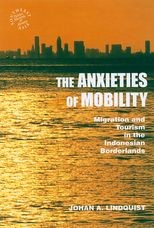The Anxieties of Mobility: Migration and Tourism in the Indonesian Borderlands
The Anxieties of Mobility: Migration and Tourism in the Indonesian Borderlands
Cite
Abstract
Since the late 1960s the Indonesian island of Batam has been transformed from a sleepy fishing village to a booming frontier town, where foreign investment, mostly from neighboring Singapore, converges with inexpensive land and labor. Indonesian female migrants dominate the island's economic landscape both as factory workers and as prostitutes. Indonesians also move across the border in search of work in Malaysia and Singapore as plantation and construction workers or maids. Export-processing zones such as Batam are both celebrated and vilified in contemporary debates on economic globalization. The book moves beyond these dichotomies to explore the experiences of migrants and tourists who pass through Batam. The book portrays globalization in terms of relationships that bind individuals together over long distances. It offers a unique ethnographic perspective, drawing together the worlds of factory workers and prostitutes, migrants and tourists, and creating an account of everyday life in a borderland characterized by dramatic capitalist expansion. The book uses three Indonesian concepts (merantau, malu, liar) to shed light on the mobility of migrants and tourists on Batam. The first refers to a person's relationship with home while in the process of migration. The second signifies the shame or embarrassment felt when one is between accepted roles and emotional states. The third is used to identify those who are out of place, notably squatters, couples in premarital cohabitation, and prostitutes without pimps. These sometimes overlapping concepts allow the book to move across geographical and metaphorical boundaries and between various economies.
Sign in
Personal account
- Sign in with email/username & password
- Get email alerts
- Save searches
- Purchase content
- Activate your purchase/trial code
Institutional access
-
Sign in through your institution
- Sign in with a library card Sign in with username/password Recommend to your librarian
Institutional account management
Sign in as administratorPurchase
Our books are available by subscription or purchase to libraries and institutions.
Purchasing information| Month: | Total Views: |
|---|---|
| February 2023 | 3 |
| February 2023 | 4 |
| February 2023 | 4 |
| February 2023 | 4 |
| February 2023 | 3 |
| February 2023 | 1 |
| February 2023 | 1 |
| February 2024 | 2 |
| April 2024 | 1 |
| April 2024 | 1 |



Get help with access
Institutional access
Access to content on Oxford Academic is often provided through institutional subscriptions and purchases. If you are a member of an institution with an active account, you may be able to access content in one of the following ways:
IP based access
Typically, access is provided across an institutional network to a range of IP addresses. This authentication occurs automatically, and it is not possible to sign out of an IP authenticated account.
Sign in through your institution
Choose this option to get remote access when outside your institution. Shibboleth/Open Athens technology is used to provide single sign-on between your institution’s website and Oxford Academic.
If your institution is not listed or you cannot sign in to your institution’s website, please contact your librarian or administrator.
Sign in with a library card
Enter your library card number to sign in. If you cannot sign in, please contact your librarian.
Society Members
Society member access to a journal is achieved in one of the following ways:
Sign in through society site
Many societies offer single sign-on between the society website and Oxford Academic. If you see ‘Sign in through society site’ in the sign in pane within a journal:
If you do not have a society account or have forgotten your username or password, please contact your society.
Sign in using a personal account
Some societies use Oxford Academic personal accounts to provide access to their members. See below.
Personal account
A personal account can be used to get email alerts, save searches, purchase content, and activate subscriptions.
Some societies use Oxford Academic personal accounts to provide access to their members.
Viewing your signed in accounts
Click the account icon in the top right to:
Signed in but can't access content
Oxford Academic is home to a wide variety of products. The institutional subscription may not cover the content that you are trying to access. If you believe you should have access to that content, please contact your librarian.
Institutional account management
For librarians and administrators, your personal account also provides access to institutional account management. Here you will find options to view and activate subscriptions, manage institutional settings and access options, access usage statistics, and more.